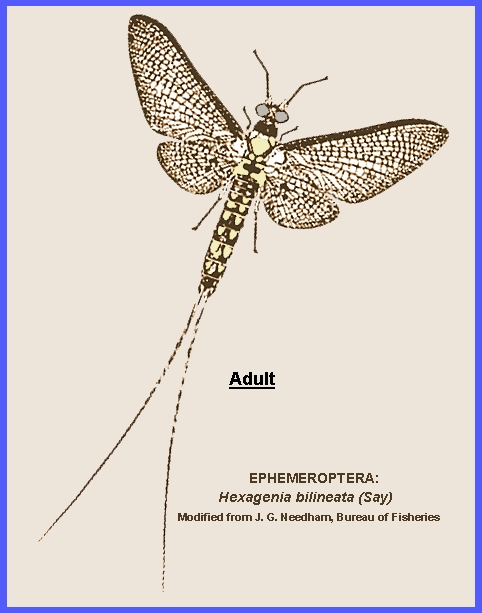File:
<ephemeroptera.htm> Indexes: < (Entomology), (Invertebrates), (General
Index)> <Invertebrate Bibliography> <Glossary> <Site Description>
< Home>
|
Entomology: EPHEMEROPTERA 1 Kingdom: Animalia, Phylum: Arthropoda Subphylum: Hexapoda: Class: Insecta: Order: Ephemeroptera (Contact) Please CLICK on underlined
subject matter to view and on included illustrations to enlarge: Depress Ctrl/F to search
for subject matter:
The Hemimetabola include
the Insect orders Ephemeroptera, Odonata and Plecoptera. These three groups do not have continuous
phylgenetic continuity. Immature
stages are called "naiads" that contrasts to the "nymphs" of
other forms. Their wings are
net-veined and all have a very high potential for reproduction. They are a primary source of food for fish
in freshwater habitats. General Summary of Ephemeroptera The term "ephemerida"
refers to the short length of adult live, which is rarely exceeds one
day. These insects appear in
tremendous numbers, emerging all at once in any given locality. They are very prominent around Green Bay,
Wisconsin where they pile up on bridges, roads, etc., causing great
annoyance.
Life Cycle. -- The eggs are laid in
water, scattered over the surface or attached to submerged stones, etc. Adult females actually enter the water in
order to lay their eggs. One female
may lay 4,000 to 5,000 eggs. Figure ent46 shows graphically the respective lengths of
the different developmental stages.
The body form varies with the
habits. Thus inhabitants of fast-flowing streams have flattened bodies with
legs provided with strong clinging claws, e.g. Ecdyonurus. Those,
which live in clear still water, have a sleek form for rapid movement, e.g. Chloeon,
while burrowing types have fossorial legs, e.g. Ephemera, and are
in some forms provided with protective gill operculae, e.g. Caenis. The
mouthparts are of the biting type, and the two-jointed mandibles and well-developed
superlinguae are features of importance. The nymphs are essentially
herbivorous feeding on vegetable matter.
Nymphal life is usually of long duration: as many as twenty-three
instars may occur. In order to emerge, the fully fed nymph creeps out of the
water on to a plant stem. A molt gives rise to the winged subimago stage. The subimago flies away and after a period
that varies, according to the species, from a few minutes to about
24-hrs. A second skin (shroud) is
cast for the final molt, which yields the short-lived adult. In the adult the mouthparts are
vestigial, no feeding is done, and the alimentary canal serves no longer for
digestion. Adult males swarm and the
females fly into the swarm to mate.
Both sexes have short, feeler-like antennae, a 10-segmented abdomen
and two or three long cerci. Compound
eyes are present. The genital
openings are paired with no common oviduct. Economic
Importance. -- Economically
these insects are of importance because they constitute a proportion of the
food of freshwater fishes, the adults being caught by fish during the
mayflies' nuptial dance, and the nymphs being devoured by bottom-feeding
fish. In Wisconsin a separate Mayfly Abatement
District was created to control mayflies. When these insects congregate in large
numbers they may cause considerable annoyance to humans and animals when they
pile up on bridges, roads, etc. Some
economic damage to structures can occur from dead individuals adhering to
surfaces. ------------------------------------------- Details of Insect
Taxonomic Groups Examples of beneficial species occur in almost every insect order, and considerable information on morphology and habits has been assembled. Therefore, the principal groups of insect parasitoids and predators provide details that refer to the entire class Insecta. These details are available at <taxnames.htm>. ============== |



